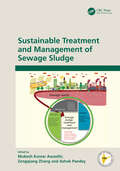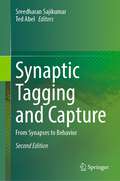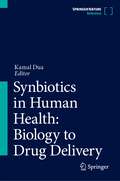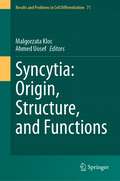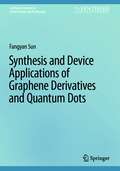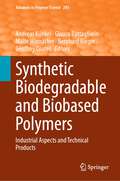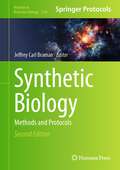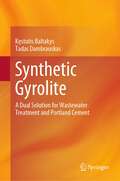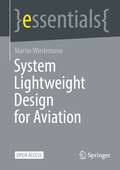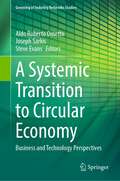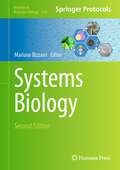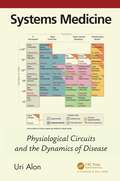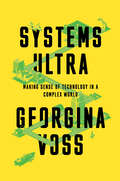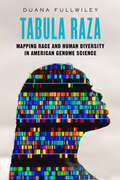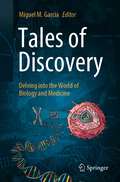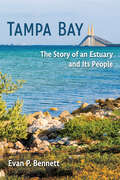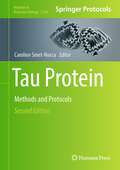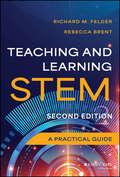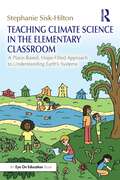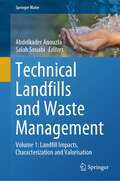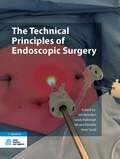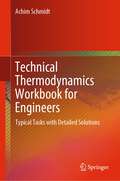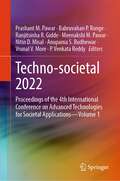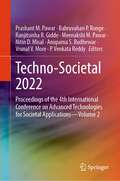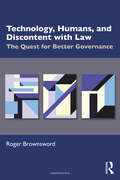- Table View
- List View
Sustainable Treatment and Management of Sewage Sludge
by Mukesh Kumar Awasthi Zengqiang Zhang Ashok PandeyThis reference book provides updated information about the technological advancement in sustainable thermochemical bioprocessing of sewage sludge disposal and resource recovery. It discusses the innovative strategies of resource recovery for the formulation of feedstock, clean compost production and safe application. This book traces the main chemical and biological properties of sewage sludge and covers biostabilization, detoxification, the role of microorganisms in sewage sludge management and the sustainable use of sewage sludge from a circular economy perspective. Key Features • Discusses organic waste disposal and recycling • Covers knowledge transfer from waste bioprocessing to commercially important end products • Includes industrial application of biological and thermochemical sewage sludge treatment toward emerging nutrient recovery technologies • Reviews the function and applications of microorganisms in sewage sludge treatment • Describes the application of sewage sludge as fertilizers in agriculture This book is meant for researchers and industry experts in environmental sciences, biochemical engineering and biotechnology.
Synaptic Tagging and Capture: From Synapses to Behavior
by Sreedharan Sajikumar Ted AbelThis reference presents a detailed exploration of the synaptic tagging and capture model, which has been proposed to provide a conceptual basis for how short-term memories are transformed into long-term memories. The first edition of Synaptic Tagging and Capture served as a comprehensive introduction and overview of the field and covered the topics from molecular and cellular aspects to behavior. This second edition reflects the overwhelming amount of research on the topic in the past five years. Notably, it provides greater insight into the molecular and cellular mechanisms and behavioral aspects of tagging and capture, including reconsolidation, computational, and metaplastic models. Synaptic Tagging and Capture: From Synapses to Behavior, 2nd edition remains the definitive work in the field.
Synbiotics in Human Health: Biology to Drug Delivery
by Kamal DuaThis reference book discusses the role of synbiotics in a wide range of disease states, including cardiovascular, reproductive, metabolic, neurodegenerative, gastrointestinal, thrombotic, skin, and inflammatory disorders. It reviews the functions of probiotics in the diagnosis, prevention, or treatment of various disease states. The book further covers improving the targeting efficiency of synbiotics through advanced drug delivery systems such as nanoparticles, microparticles, liposomes, microemulsion, solid lipid nanoparticles, and nano lipid carriers. The chapter addresses the implications of oral and topical delivery of synbiotics in different diseases and presents the safety assessment of synbiotics and clinical trials associated with synbiotics containing drug delivery systems for the treatment of diseases. The book also explores the synergistic welfare of synbiotics nutraceuticals in various conditions such as chronic respiratory diseases, gut health, and neurological functions and examines the toxicological profile, and regulatory aspects of nutraceutical supplements. As such, this book is a valuable resource for academics, research and industry professionals working in Pharmaceutical Sciences, Food Biotechnology, Immunology, and Health Sciences.
Syncytia: Origin, Structure, and Functions (Results and Problems in Cell Differentiation #71)
by Malgorzata Kloc Ahmed UosefThis book gives a current overview on the development, origin, structure, and functions of germline and somatic cell syncytia during embryogenesis and organogenesis. It also reviews pathogen-induced syncytia and the role of syncytial cells in cancer development.The book covers the following topics:germline syncytia, evolution, function and structure; syncytia in embryogenesis and development; the role of somatic cell fusion in fungi, specialized somatic tissues, host defense and adaptation; syncytia induced by viruses and parasites;syncytia and circulating hybrid cells in cancer and other pathological conditions; It also discusses how the genomic adaptations of microorganisms to extreme habitats can prompt the evolution of mononuclear and multinucleate/syncytial cells. The book offers a fresh outlook on syncytia's role in various processes: embryogenesis, organogenesis, adaptation, host defense, and development of specialized tissues. It highlights the importance of syncytia under physiological and pathological conditions.
Synthesis and Device Applications of Graphene Derivatives and Quantum Dots (Synthesis Lectures on Green Energy and Technology)
by Fangyan SunThe book explores the synthesis methods and device applications of graphene derivatives and quantum dots. The book offers a detailed overview of the synthesis techniques used for these advanced nanomaterials, including solution-phase synthesis, and surface functionalization. It delves into the unique properties and characteristics of graphene derivatives and quantum dots, highlighting their potential for revolutionizing electronic devices. The book also addresses the challenges and limitations associated with their synthesis and device integration, providing valuable insights for researchers and professionals in the field. Written by experts in the field, this book serves as a valuable resource for scientists, engineers, and students interested in exploring the vast potential of graphene derivatives and quantum dots in the development of innovative devices with enhanced performance and functionality.
Synthetic Biodegradable and Biobased Polymers: Industrial Aspects and Technical Products (Advances in Polymer Science #293)
by Andreas Künkel Glauco Battagliarin Malte Winnacker Bernhard Rieger Geoffrey CoatesThis volume presents the recent developments in synthetic biodegradable and biobased polymers. The syntheses of many polymer types such as polyesters and polyamides, and also their processing technologies are discussed herein, and new aspects from fundamental and from industrial research are covered. This combination of both perspectives within this volume will be of interest for many research scientists from academia and industry and also for lectures and teachers. Chapters ''BioPBSTM (Polybutylene succinate)'' and ''Polymer biodegradability 2.0: A holistic view on polymer biodegradation in natural and engineered environments'' are available open access under a Creative Commons Attribution 4.0 International License via link.springer.com. For further details see license information in the chapter.
Synthetic Biology: Methods and Protocols (Methods in Molecular Biology #2760)
by Jeffrey Carl BramanThis second edition provides new and updated techniques and applications associated with synthetic biology. Chapters guide readers through the creation and regulation of gene circuits, manipulation of biochemical pathways, genome editing and modification, creating genome language and computing, as well as molecular assembly.Written in the highly successful Methods in Molecular Biology series format, chapters include introductions to their respective topics, lists of the necessary materials and reagents, step-by-step, readily reproducible laboratory protocols, and key tips on troubleshooting and avoiding known pitfalls. Authoritative and cutting-edge, Synthetic Biology: Methods and Protocols, Second Edition aims to ensure successful results in the further study of this vital field.
Synthetic Gyrolite: A Dual Solution for Wastewater Treatment and Portland Cement
by Kęstutis Baltakys Tadas DambrauskasThis book explores the topic of gyrolite and calcium silicate hydrates, focusing on their potential applications in wastewater purification and as additives in ordinary Portland cement. Divided into five chapters, the book provides a comprehensive description of calcium silicate hydrates and addresses challenges in reusing solid waste. It also covers the synthesis and application of gyrolite, offering technological recommendations for future studies. The results presented are supported by instrumental analysis techniques and thermodynamic calculations, allowing readers to delve into inorganic chemistry and materials characterization. The book is suitable for both researchers and students interested in chemistry and materials characterization, offering valuable insights and guidance in the field.
System Lightweight Design for Aviation (essentials)
by Martin WiedemannThis open access book presents technologies and methods of lightweight system design to support future low-emission aviation in achieving climate targets. It will be shown how reduction of weight and aerodynamic drag affects the energy consumption of commercial aircraft and what characterizes lightweight system design. Methods, design principles, production technologies and options for functional integration are available for more energy-efficient aircraft. Research results from the last decade are presented, which are intended to encourage the reader to further research and, above all, to implement them in future aircraft.
A Systemic Transition to Circular Economy: Business and Technology Perspectives (Greening of Industry Networks Studies #12)
by Aldo Roberto Ometto Joseph Sarkis Steve EvansThe book will explore, using multiple perspectives from multiple contributors, two main aspects for circular economy (CE) business and technology (B&T): systems and value perspectives. Going beyond a linear-economic perspective--the traditional perspective--CE needs to develop intentional and integrated paths to help restore physical resources and regenerate the functions of natural and anthropic systems, creating greater economic and social opportunities, with environmentally positive outcomes. Whether this is feasible and possible within the context of CE and B&T is something that will be central to the contributions made in this book. A major objective of the book is to deliver practical and fundamental knowledge of B&T CE insights combining a systems perspective and value creation for socio-technical innovation leading to sustainable transitions and effective transformations. Based on those key aspects, the book is structured in two parts, one from a more theoretical and conceptual basis in Part 1, and a more applied perspective in Part 2. The chapters in Part 1 are presented through the lens of business and systems transitions. In Part 2, the chapters present the opportunities and the journeys from real case studies of companies engaged in circular business strategies, processes, practices, and technologies.
Systems Biology (Methods in Molecular Biology #2745)
by Mariano BizzarriThis second edition volume expands on the previous edition with discussions of the latest advancements and methods used by scientists to study systems biology. The chapters in this book are organized into four parts. Part One looks at models in systems biology and parameters identification such as short peptide analysis, metastasis models, and metabolomics. Part Two covers computational methods in the study of organisms, and cancer non-linear dynamics. Part Three discusses critical transition states across Waddington’s like landscapes such as understanding cell differentiation through single-cell approaches and modeling mammary organogenesis from biological first principles. Part Four talks about specific fields of investigation including inborn errors of metabolism, system biology approach in epithelial-mesenchymal transition, and an approach to understanding how COVID-19 spreads in the population. Written in the highly successful Methods in Molecular Biology series format, chapters include introductions to their respective topics, lists of the necessary materials and reagents, step-by-step, readily reproducible laboratory protocols, and tips on troubleshooting and avoiding known pitfalls.Cutting-edge and comprehensive, Systems Biology, Second Edition is a valuable tool for any researcher looking to learn more about this important and developing field.
Systems Medicine: Physiological Circuits and the Dynamics of Disease (Chapman & Hall/CRC Computational Biology Series)
by Uri AlonWhy do we get certain diseases, whereas other diseases do not exist? In this book, Alon, one of the founders of systems biology, builds a foundation for systems medicine. Starting from basic laws, the book derives why physiological circuits are built the way they are. The circuits have fragilities that explain specific diseases and offer new strategies to treat them. By the end, the reader will be able to use simple and powerful mathematical models to describe physiological circuits. The book explores, in three parts, hormone circuits, immune circuits, and aging and age-related disease. It culminates in a periodic table of diseases. Alon writes in a style accessible to a broad range of readers - undergraduates, graduates, or researchers from computational or biological backgrounds. The level of math is friendly and the math can even be bypassed altogether. For instructors and readers who want to go deeper, the book includes dozens of exercises that have been rigorously tested in the classroom
Systems Ultra: Making Sense of Technology in a Complex World
by Georgina VossA TOOLBOX FOR COMPREHENDING — AND CHANGING — THE WORLDSystems Ultra explores how we experience complex systems: the mesh of things, people, and ideas interacting to produce their own patterns and behaviours.What does it mean when a car which runs on code drives dangerously? What does massmarket graphics software tell us about the workplace politics of architects? And, in these human-made systems, which phenomena are designed, and which are emergent? In a world of networked technologies, global supply chains, and supranational regulations, there are growing calls for a new kind of literacy around systems and their ramifications. At the same time, we are often told these systems are impossible to fully comprehend and are far beyond our control.Drawing on field research and artistic practice around the industrial settings of ports, air traffic control, architectural software, payment platforms in adult entertainment, and car crash testing, Georgina Voss argues that complex systems can be approached as sites of revelation around scale, time, materiality, deviance, and breakages. With humour and guile, she tells the story of what &‘systems&’ have come to mean, how they have been sold to us, and the real-world consequences of the power that flows through them.Systems Ultra goes beyond narratives of technological exceptionalism to explore how we experience the complex systems which influence our lives, how to understand them more clearly, and, perhaps, how to change them.
Tabula Raza: Mapping Race and Human Diversity in American Genome Science (Atelier: Ethnographic Inquiry in the Twenty-First Century #14)
by Duana FullwileyDuana Fullwiley has penned an intimate chronicle of laboratory life in the genomic age. She presents many of the influential scientists at the forefront of genetics who have redefined how we practice medicine and law and understand ancestry in an era of big data and waning privacy. Exceedingly relatable and human, the scientists in these pages often struggle for visibility, teeter on the tightrope of inclusion, and work tirelessly to imprint the future. As they actively imagine a more equal and just world, they often find themselves ensnared in reproducing timeworn conceits of race and racism that can seed the same health disparities they hope to resolve. Nothing dynamic can live for long as a blank slate, an innocent tabula rasa. But how the blank slate of the once-raceless human genome became one of racial differences, in various forms of what Fullwiley calls the tabula raza, has a very specific and familiar history—one that has cycled through the ages in unexpected ways.
Tales of Discovery: Delving into the World of Biology and Medicine
by Miguel M. GarciaResearch data sharing has traditionally been addressed to other peer researchers. Nowadays there is general awareness that putting research at the disposal of society is beneficial and necessary. However, the popularization of science is a hard endeavor. It must deal with transmission of transcendental knowledge with the appealing adornment of a good story, but avoiding the risk of falling into banality. This book consists in a series of individual stories delving into the world of biology and medicine. Some topics included in this volume consist in the explanation of basic biological concepts like the origin of modern eukaryotic cells, the importance of mutations as the driving force behind evolution, the molecular ins and outs of the nervous system, or the relevance of microorganisms to humans and science including food and energy industries. Others rather lean to a more biomedical perspective and constitute popular cases that have been, to some extent, trending in global media outlets: the divulgation of some current under-reckoned non-infectious pandemics like obesity and chronic pain, the presence of longer-living populations around the world named blue zones, the American (and African) opioid crisis, or the discovery and development of CRISPR-Cas as a promising genetic editing tool. All chapters are depicted with accompanying illustrations thoroughly elaborated by professionals of Fine Arts to make it easier to understand for the non-experts… but may perhaps also proof that the scientific method and multidisciplinary work are not unique to natural sciences, but also shared by other apparently distant disciplines like arts.
Tampa Bay: The Story of an Estuary and Its People (Florida in Focus)
by Evan P. BennettExploring the environmental history of an important natural area The largest open water estuary in Florida, Tampa Bay has been a flashpoint of environmental struggles and action in recent years. This book goes beneath today’s news headlines to explore how people have interacted with nature in the region throughout its long history. In Tampa Bay, Evan Bennett reveals that humans have been part of the bay’s ecology since the estuary took its modern form 2,000 years ago, along with the communities of fish, birds, reptiles, and mammals that proliferated in its seagrass meadows, tidal salt flats, and mangrove forests. Bennett discusses the natural resources that drew people to settle there, the trade that encouraged development, and the shipping and industry that increased biological and ecological change. While the past 150 years have seen serious environmental damage from dredging, water pollution, red tides, and more, Bennett shows how people have been fighting to clean up the bay and regain a balance with nature. Informed by the latest in marine science, area environmentalists, policymakers, and citizens are working to create a model for other societies that have developed in fragile natural areas. The first book to examine the environmental history of the region, Tampa Bay uncovers deep-rooted relationships between water, land, and people and offers hope for bringing threatened coastal spaces back from the brink. A volume in the series Florida in Focus, edited by Andrew K. Frank
Tau Protein: Methods and Protocols (Methods in Molecular Biology #2754)
by Caroline Smet-NoccaThis volume explores the latest advancements and techniques to study Tau protein that include basic and advanced methods and protocols from in vitro assays to in vivo models that address the molecular and functional aspects of tau physiopathology and many of its related technical issues. The chapters in this book are organized into five parts: Part One describes conformational and functional studies of native tau protein using wet and non-wet lab protocols. Part Two looks at in vitro methods to monitor or control the formation of Tau oligomers and fibrils, and the fibrillization process. Part Three provides protocols for the characterization and in vitro introduction of post-translational modifications in Tau protein for further functional studies. Part Four describes analytical tools for the detection of Tau proteins under various forms, factors associated with Tau pathology, and MAPT gene studies. Finally, Part Five explores cellular and in vivo models for the investigations of Tau physiopathology. Written in the highly successful Methods in Molecular Biology series format, chapters include introductions to their respective topics, lists of the necessary materials and reagents, step-by-step, readily reproducible laboratory protocols, and tips on troubleshooting and avoiding known pitfalls.Cutting-edge and comprehensive, Tau Proteins: Methods and Protocols, Second Edition is a valuable tool for any researcher interested in learning more about this important and developing field related to Tau protein as a relevant and attractive target for neurodegeneration therapies.
Teaching and Learning STEM: A Practical Guide
by Richard M. Felder Rebecca BrentThe widely used STEM education book, updated Teaching and Learning STEM: A Practical Guide covers teaching and learning issues unique to teaching in the science, technology, engineering, and math (STEM) disciplines. Secondary and postsecondary instructors in STEM areas need to master specific skills, such as teaching problem-solving, which are not regularly addressed in other teaching and learning books. This book fills the gap, addressing, topics like learning objectives, course design, choosing a text, effective instruction, active learning, teaching with technology, and assessment—all from a STEM perspective. You’ll also gain the knowledge to implement learner-centered instruction, which has been shown to improve learning outcomes across disciplines. For this edition, chapters have been updated to reflect recent cognitive science and empirical educational research findings that inform STEM pedagogy. You’ll also find a new section on actively engaging students in synchronous and asynchronous online courses, and content has been substantially revised to reflect recent developments in instructional technology and online course development and delivery. Plan and deliver lessons that actively engage students—in person or online Assess students’ progress and help ensure retention of all concepts learned Help students develop skills in problem-solving, self-directed learning, critical thinking, teamwork, and communication Meet the learning needs of STEM students with diverse backgrounds and identitiesThe strategies presented in Teaching and Learning STEM don’t require revolutionary time-intensive changes in your teaching, but rather a gradual integration of traditional and new methods. The result will be a marked improvement in your teaching and your students’ learning.
Teaching Climate Science in the Elementary Classroom: A Place-Based, Hope-Filled Approach to Understanding Earth’s Systems
by Stephanie Sisk-HiltonDiscover new ways to help elementary students engage with and understand the world around them through place-based, hope-filled learning about the causes, impacts, and responses to climate change. This book features foundational climate concepts, easily implementable activity plans, and inspiring examples of student engagement. Each chapter begins with a short vignette pulled from the author’s considerable teaching experience in engaging students in concepts of climate change and climate justice, followed by content-focused sections and recommendations for student activities and projects. The author provides stories of hope-filled action to invite teachers to look for and reflect on similar narratives in their own communities. Sample units of study for grades K-5 show teachers how key ideas from each chapter come together into an instructional plan that incorporates the three dimensions of NGSS and can fit into the broader outline of their school year. This resource is an accessible tool to support any elementary educator in building their own knowledge base and integrating the important and timely issues of climate change into their classroom.
Technical Landfills and Waste Management: Volume 1: Landfill Impacts, Characterization and Valorisation (Springer Water)
by Abdelkader Anouzla Salah SouabiA "zero waste" society and the "circular economy" trend are urgently needed. Even if achieving 100% trash recycling and a fully circular economy may not always be attainable, aiming toward this goal might result in a sustainable future. Municipal solid wastes pose a hazard to the environment because of open burning, landfills, reckless disposal, and many other factors. Waste is being thrown away in more significant quantities and is made up of several different materials. Municipal solid waste (MSW) characteristics must be carefully considered when developing, implementing, or modifying solid waste management systems. Local waste variables that vary with cultural, climatic, socioeconomic, and institutional capacities are crucial for developing efficient waste management techniques. This book provides a comprehensive overview of landfills' situation, their categories, and the types of garbage they receive. The final section of the study provides an overview of prospective waste management techniques, their restrictions, and the potential areas for further research on landfill sites. This book has the advantage that world-class experts in their respective fields have written each chapter. As a result, this book presents a balanced picture across the whole spectrum of chapters on municipal solid wastes.
The Technical Principles of Endoscopic Surgery
by Ivo Broeders Sandy Kalisingh Silvana Perretta Amir SzoldThe introduction of laparoscopic surgery as a standard technique marked a revolution in operating theaters around the globe. Over thirty years later, almost every disorder in the thorax and abdomen eligible for surgery can be approached by endoscopic techniques. We have witnessed a unique journey of technical innovations that enables surgeons to work with this minimally invasive approach in the most complex procedures.Benefits to the patient are clear, by reducing external and internal trauma, and surgeons are supported by advanced technology that has increased their options to see, dissect and repair in ways that were beyond imagination. With the new options came a completely new working environment,that is dictated by advanced surgical and digital technologies. This requires investment in a new knowledge domain, while medical and surgical training still strongly focusses on anatomy, physiology and pathology.The lack of in-depth knowledge on high tech surgical equipment and workplaces is recognized among surgeons and OR staff, but educational programs are late to adapt. This book fulfills the need for a comprehensive overview on a wide variety of technical aspects of endoscopic surgery, that need to be understood in detail before starting to work in practice. In this book, international experts explain and share their expertise to contribute to education, efficiency and patient safety in the technological aspects of endoscopic surgery.The book is written for all healthcare workers who are directly or indirectly involved with endoscopic surgery, from surgeons to OR assistants and nurses, and from Techmed student and OR managers to sterilization specialists. The book covers extensively surgical instruments, hardware for endoscopic surgery and the surgical work environment. It can be used as a textbook, or as a reference book for knowledge on any of the topics covered.This book addresses the growing need for knowledge about technologies that will continue to shape the future of surgery and operating rooms.
Technical Thermodynamics Workbook for Engineers: Typical Tasks with Detailed Solutions
by Achim SchmidtThis book offers a comprehensive collection of typical tasks from technical thermodynamics. It is ideal for preparing written and oral examinations at university. It contains 180 tasks that are solved in detail. Alternative solution strategies are often shown and discussed. The book is interesting for all engineering students who have to take an exam in thermodynamics. A problem-orientated approach is followed and a systematic method for solving the tasks is developed. Theoretical correlations and thermodynamic fundamentals are solved by means of concrete tasks. In addition to comprehension questions, the book contains numerous typical calculation problems. Here, too, the basics are summarised and solutions respectively solution strategies are discussed. These are conceived to provide students with strategies and tools to solve complex tasks. All these exercises should help to deepen the physical knowledge. The greater the technical competence, the more confidently one can face the exam! At best, the tasks will help you to have fun and enjoy thermodynamics! This book is a perfect complement to my textbook "Technical Thermodynamics for Engineers".
Techno-societal 2022: Proceedings of the 4th International Conference on Advanced Technologies for Societal Applications—Volume 1
by Prashant M. Pawar Babruvahan P. Ronge Ranjitsinha R. Gidde Meenakshi M. Pawar Nitin D. Misal Anupama S. Budhewar Vrunal V. More P. Venkata Reddy“This book, divided into two volumes, originates from Techno-Societal 2022: the 4th International Conference on Advanced Technologies for Societal Applications, Maharashtra, India. The conference brings together faculty members from various engineering colleges to solve relevant regional problems in India, under the guidance of eminent researchers from various reputed organizations.The focus of Volume - I is on technologies that help develop and improve society, with particular emphasis on sensor and ICT-based technologies for the betterment of people, technologies for agriculture and healthcare, micro and nano technological applications, as well as Artificial Intelligence and Big Data.Volume - II delves into commercially successful rural and agricultural technologies, engineering for rural development, ICT-based societal applications, manufacturing and fabrication processes for societal applications, material science & composites, and sensor, image, and data-driven societal technologies.This conference aims to provide a platform for innovators to share their best practices or products developed to solve specific local problems, which in turn may inspire other researchers to solve similar problems in their regions. Additionally, technologies proposed by expert researchers may find applications in different regions, making it a multidisciplinary platform for reporting innovations at different levels in Science, Engineering, and Technology.”
Techno-Societal 2022: Proceedings of the 4th International Conference on Advanced Technologies for Societal Applications—Volume 2
by Prashant M. Pawar Babruvahan P. Ronge Ranjitsinha R. Gidde Meenakshi M. Pawar Nitin D. Misal Anupama S. Budhewar Vrunal V. More P. Venkata Reddy“This two-volume book originates from Techno-Societal 2022, the 4th International Conference on Advanced Technologies for Societal Applications held in Maharashtra, India. The conference brought together faculty members from various engineering colleges and eminent researchers from reputed organizations to solve Indian regional relevant problems.The focus of the Volume-I is on technologies that help develop and improve society, with a particular emphasis on issues such as advanced and sustainable technologies for water, energy, transportation, housing, and sanitation. Additionally, the book covers advances in pharmacy, nutraceuticals, and traditional medicines, as well as chemical and physical processes.The Volume-II covers deployable environment or health care technologies, mechatronics, micro-nano related technologies for bio and societal applications, and advanced assessment of employees and employment sectors.The conference aims to provide a platform for innovators to share their best practices or products developed to solve specific local problems, which in turn may inspire other researchers to solve problems in their own regions. Expert researchers also propose technologies that may find applications in different regions, providing a multidisciplinary platform for researchers from a broad range of disciplines of science, engineering, and technology to report innovations at different levels.”
Technology, Humans, and Discontent with Law: The Quest for Better Governance
by Roger BrownswordThis book analyses discontent with law and assesses the prospect of better governance by technology. In the first part of the book, where the context is ‘low tech’, the range of discontent with law is examined; the underlying reasons for such discontent are identified (namely, the human nature of the legal enterprise, its reliance on rules, and the pluralistic nature of human communities); and the reasonableness of such discontent is assessed. In the second part of the book, where the context is ‘high-tech’ (with new tools becoming available to undertake governance functions), the question is whether discontent with law is further provoked or, to the contrary, is eased. While new technologies provoke further discontent with law’s claimed authority, its ineffectiveness, and its principles, positions, and policies, they also promise more effective and efficient ways of achieving order. The book closes with some reflections on the ambivalence that humans might experience when faced with the choice between law’s governance and apparently better performing governance by technology. That law’s governance is imperfect is undeniable; that humans should quest after better governance is right; but, the shape of our technological futures is unclear. This accessibly written book will appeal to scholars and students who are working in the broad and burgeoning field of law, regulation, and technology, as well as to legal theorists, political scientists, and sociologists with interests in the impact of new technology.
